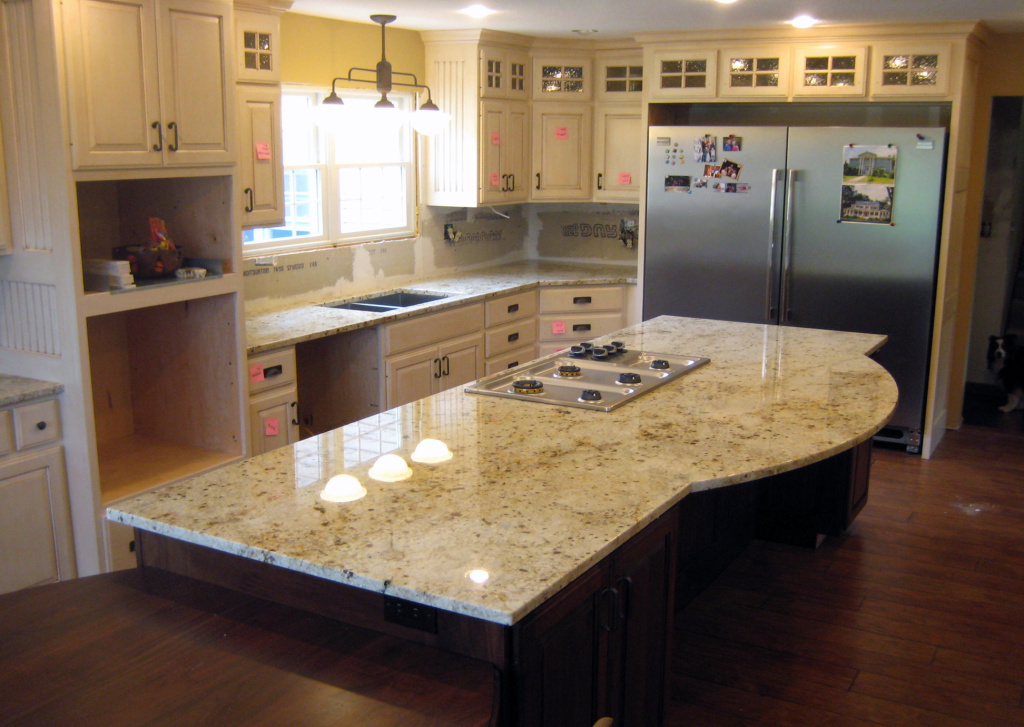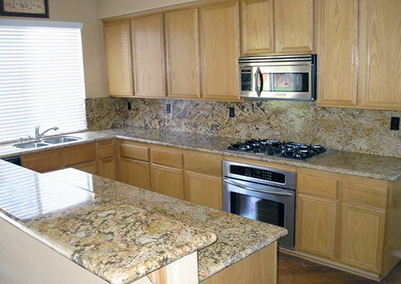Colonial gold granite is a stunning cream and white stone that is loved for its golden cream tones. It is quarried in Pottal, India and is occasionally called café cream granite. It’s a great stone that looks at home in any kitchen.
Due to the high level of variation between slabs this granite can have a variety of different appearances from afar. At a distance its overall color is always a stunning creamy tone – depending upon the slab this can be very light cream, or can be a warm golden color. From afar its appearance can be reasonably uniform – or it can be heavily patterned, with visible golden mineral deposits and veins.

The white cabinets are only slightly lighter than the colonial gold countertops here. See how the room flows?
As you get a little closer to the stone you can see a variety of minerals and colors that are not really visible from a distance.
The overall cream color of this stone is provided by the stunning bedrock. This can make up anywhere between 50% to 70% of the stones overall mass. The bedrock is usually very uniform in its color – which creates a great light / neutral backdrop for the complex patterns created by the mineral deposits we will list below.
The stone is littered with small grey mineral deposits, these are actually quartz and can range in color from a very light grey (almost white), through to a medium grey. These stunning little crystals add a shine and sparkle to the stone – and look great when exposed to lots of natural light. They are usually quite infrequent and make up around 10% of the stones overall mass on average.
The large golden patches that give this granite its name are the most predominant feature of most slabs. They can range drastically in size and can cover anywhere between 20% and 70% of the stones surface. They can range in color from a very light amber, all the way through to a stunning warm golden tone. They are usually found in both isolated patches – and large long winding veins. They complement the grey quartz deposits and the cream bedrock beautifully creating a warm and luxurious effect.
Littered throughout the stone will be smaller darker mineral deposits. These are usually very dark brown or even burgundy in color. They are usually quite infrequent and will cover between 5% and 10% of the slabs surface on average. They add a great little stark contrast to the light golden and cream tones and provide the slab with a lovely hidden feature that is not usually visible from afar.
All granites are rated on their amount of variation between slabs. Granites that generally look the same no matter what are said to have a low rating and granites that can look very different are said to have a high rating. Well this granite has a high rating – and no two slabs will look alike.
All aspects of the stones appearance can vary – however in this stone the main variant will be the amount of golden minerals that are present. Some slabs can be nearly covered in this golden mineral – giving a much darker and richer appearance.
These slabs look much less uniform from afar and look much busier. At the other end of the scale are slabs that have nearly no golden minerals – these look much lighter and more uniform creating an elegant feel.
No one slab can be said to be better than the other and everyone has their personal tastes. If you have a preference you should ask your stone dealer to see if they have any slabs that are suited to your tastes. Take a look in person if possible – but if not, a high quality photo should suffice.
The light color of this granite means that it will not show up fingerprints easily, and crumbs and dirt will be reasonably hidden. Which means you will not have to do much additional cleaning to your countertops just because they are made out of granite. This stone is occasionally known stain if you do not take care of it. Be sure to not use any harsh chemical cleaning products on it – while most household cleaners will be fine, we recommend that you use a specialized granite cleaner. As due to the light and pristine nature of this stone – the stains will be easily visible if they appear – and can be a nightmare to remove.
How Much Does Colonial Gold Granite Cost?
This is a mid range granite due to its beauty and popularity. For a 3cm thick slab of colonial gold granite you will pay in the region of $55 to $65 per square foot. We were unable to find quotes for a 2cm thick slab.
When you combine colonial gold granite countertops with dark cabinets your kitchen will take on a modern and “serious” feel to it. The contrast between the cream bedrock and the white granite is not too stark, but is certainly there.
The brown mineral content in the stone will tie the cabinets and countertops together slightly so the difference in color is slightly less bold overall. The more golden minerals that are present in the stone will affect the overall appearance of the room drastically. The more golden minerals – the less stark the contrast will be.

Cream cabinets and colonial cream countertops almost sound like they would be a little too much – i love it! What do you think?
When combined with light or white cabinets, colonial gold countertops are a lovely accent to the stark white. The cream bedrock only being slightly darker than the white creates a flowing and natural feel the room. Again the amount of golden minerals in the stone will affect the overall appearance here. Less gold will create a more pristine and minimal feel to the room, more gold will create a more regal and luxurious effect.
When combined with natural wood, or medium stained cabinets this granite is at its most subtle. The earthy tones of the golden minerals will complement and match with the brown cabinets and creates a very “natural” feel to the room. The countertops almost become slightly understated and seamlessly blend in with the other decor.
Regardless of your room’s décor, we highly recommend you consider getting a colonial gold splashback. Even if it is only a small piece – the overall effect is well worth the money in our opinion.
And finally, using colonial gold granite has always been popular in the bathroom. Its stunning warm tones will look great on any bathroom vanity and are a great way to add a little luxury to the room’s décor.
A couple of similar granites that we recommend you look at are colonial cream granite and golden beach granite.
Do you have any questions? We would love to hear your opinions! Please leave a comment in the box below.












